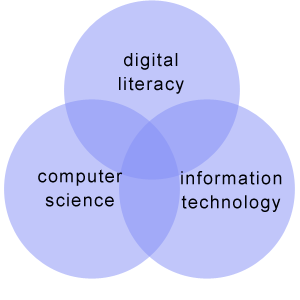The three main strands within computing
The Royal Society has identified three distinct strands within computing, each of which is complementary to the others: computer science (CS), information technology (IT) and digital literacy (DL). (See the Royal Society report for further details.) Each component is essential in preparing pupils to thrive in an increasingly digital world.

Computer science is the scientific and practical study of computation: what can be computed, how to compute it, and how computation may be applied to the solution of problems.
Information technology is concerned with how computers and telecommunications equipment work, and how they may be applied to the storage, retrieval, transmission and manipulation of data.
Digital literacy is the ability to effectively, responsibly, safely and critically navigate, evaluate and create digital artefacts using a range of digital technologies.
The creation of digital artefacts will be integral to much of the learning of computing. Digital artefacts can take many forms, including digital images, computer programs, spreadsheets, 3D animations and this booklet.

